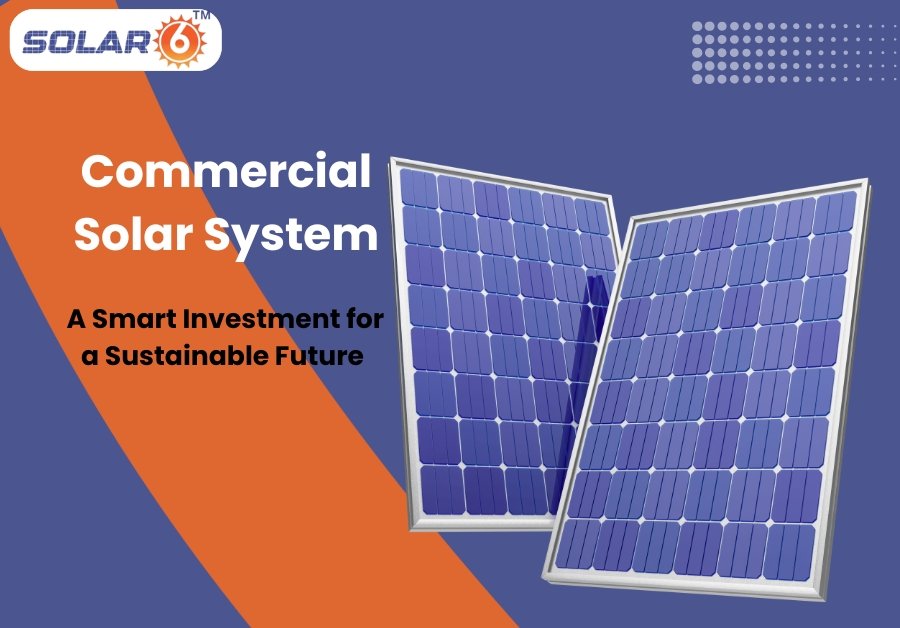As businesses worldwide face rising energy costs and increasing pressure to reduce their carbon footprint, many are turning to renewable energy sources to stay competitive and remain environmentally responsible. Among those alternatives, enterprise solar structures have emerged as a game-changing solution. From small enterprises to multinational companies, the adoption of solar energy is transforming how organizations enhance their operations while saving money and promoting sustainability.
In this comprehensive Guide, Solar6 explores what industrial solar structures are, their additives, how they paintings, their numerous advantages, and why now’s the perfect time for organizations to make the switch to solar.
1. What is a Commercial Solar System?
An industrial solar system is a photovoltaic (PV) power solution designed specifically for businesses, homes, places of work, warehouses, factories, or any enterprise facility. Unlike residential solar structures, which might normally be smaller in scale, business solar setups are constructed to generate better power output, meeting the larger and more demanding energy needs of enterprise operations.
These systems convert sunlight into usable electricity through solar panels installed on rooftops, parking lots, or unused land. The energy produced can be used to power lighting, HVAC systems, equipment, and office equipment. Any excess power can be stored or fed back into the grid, offering additional financial returns through net metering or electricity buy agreements (PPAs).
2. Key Components of a Commercial Solar System
An industrial solar system includes several interconnected components that work together to produce and distribute clean energy:
a. Solar Panels
The most visible part of the system, solar panels are made of photovoltaic cells that convert sunlight into direct Current (DC) power.
b. Inverters
Commercial operations are powered by alternating current (AC) electricity that inverters transform from the DC electricity produced by the panels.
c. Mounting Structures
These hold the panels in place on rooftops, ground areas, or carports, making sure top-of-the-line tilt and orientation for maximum power technology.
D. Electrical Wiring and Panels
These deliver the generated energy to the building’s electrical systems, integrating with the present infrastructure.
E. Monitoring System
Advanced monitoring systems track energy production, system overall performance, and potential troubles in real-time, allowing businesses to optimize usage and maintain efficiency.
3. How Do Commercial Solar Systems Work?
The operation of a Commercial solar system is relatively simple yet highly efficient:
- Sunlight hits the solar panels, which contain photovoltaic (PV) cells made of semiconductor substances like silicon.
- The PV cells generate DC electricity while exposed to sunlight.
- This DC power flows to an inverter, which converts it to AC electricity—the standard form used by most businesses.
- The AC electricity is then used to power commercial operations.
- Any additional electricity can be transferred to the application grid through net metering processes or saved in batteries for later use.
Some businesses additionally enforce hybrid systems, which combine solar panels with energy storage and backup generators to ensure a Continuous power supply during outages or cloudy days.
4. Benefits of Commercial Solar Systems
Investing in an industrial solar device offers an array of benefits that extend beyond cost savings:
a. Cost Reduction
The substantial decrease in electricity costs is among the strongest arguments for switching to solar power.. Solar power provides free energy after the initial installation cost, and over time, businesses can save thousands—or even millions—depending on system size.
b. Energy Independence
By producing their electricity, businesses reduce their reliance on utility businesses and protect themselves against rising energy prices.
C. High Return on Investment (ROI)
Commercial solar systems commonly offer an ROI of 10–30% per year. With incentives, tax benefits, and electricity savings, most systems pay for themselves in 3–7 years.
D. Environmental Impact
Switching to solar reduces a company’s carbon footprint. Using clean, renewable energy enables businesses to meet sustainability desires and appeal to eco-conscious consumers.
e. Government Incentives
Many governments offer attractive incentives such as tax credits, rebates, accelerated depreciation, and grants to make solar adoption more affordable.
f. Enhanced Brand Image
Going solar signals environmental responsibility and forward-thinking values. Businesses that adopt green technologies improve their public perception and attract socially conscious clients and investors.
g. Reliable Power Supply
Solar systems are low-maintenance and have long lifespans—often 25 years or more. Adding battery storage increases reliability, especially in regions with unstable power grids.
h. Scalability
Commercial solar solutions are scalable and customizable to meet future growth. As their energy requirements increase, businesses may readily extend their systems.
5. Types of Commercial Solar Installations
Depending on space availability and energy needs, businesses can choose from several installation types:
a. Rooftop Solar Systems
These are the most common and cost-effective systems, utilizing otherwise unused roof space for panel installation.
b. Ground-Mounted Solar Systems
Ideal for businesses with large land areas, ground-mounted systems can be adjusted for optimal orientation and performance.
c. Solar Carports
These serve dual purposes—generating electricity while providing shade and protection for vehicles in parking lots.
d. Building-Integrated Photovoltaics (BIPV)
In this innovative approach, solar panels are incorporated into the building substances, which include home windows, facades, and roofs, blending aesthetics with functionality.
6. Financial Models for Commercial Solar Projects
Businesses can select from numerous monetary models primarily based on their finances, dreams, and options:
a. Direct Purchase
The enterprise purchases the gadget outright, receiving full tax benefits and long-term savings.
B. Power Purchase Agreement (PPA)
A Third party installs and owns the machine, and the business agrees to buy electricity at a hard and fast fee, typically decrease than utility costs.
c. Solar Leasing
Similar to a PPA, but with a lease agreement instead of purchasing power. It lowers upfront costs and still provides savings.
d. Solar Loans
These allow businesses to finance their systems with little to no upfront cost while enjoying ownership benefits over time.
Each model has its pros and cons, and businesses should consult with solar consultants or financial advisors to determine the best fit.
7. Factors to Consider Before Installing a Commercial Solar System
Before making the transition to solar energy, organizations have to consider several essential factors:
Energy Usage: Understand your employer’s energy consumption and styles.
Available Space: Assess the roof or land space to determine what number of panels that may be set up.
Shading and Orientation: Trees, houses, or different obstructions can reduce performance.
Local Regulations and Permits: Compliance with zoning legal guidelines and software program rules is crucial.
Budget and Financing: Examine ROI estimates, financing options, and incentives.
Installer Reputation: Choose an authorized and experienced solar installation enterprise for pleasant and reliable service.
8. Maintenance and Monitoring
While industrial sun structures require minimal protection, regular inspections and cleaning ensure the finest overall performance. Monitoring software program offers real-time facts, signals, and analytics to help groups hit upon troubles early and make informed energy choices.
Key maintenance activities include:
- Cleaning panels to remove dust, debris, and bird droppings.
- Inspecting wiring and inverters.
- Monitor performance data regularly.
- Scheduling annual professional checkups.
- With proper maintenance, a commercial solar system can function efficiently for 25–30 years.
9. Commercial Solar Trends in 2025
- The commercial solar enterprise maintains to conform to technological innovations and coverage support. Some key inclinations shaping 2025 encompass:
- Bifacial solar panels capture daylight from both sides, increasing the strength of the output.
- AI and Smart Monitoring: Artificial intelligence is being used to assess overall performance, optimize electricity use, and decrease downtime.
- Battery Storage Integration: More organizations are pairing solar with batteries for round-the-clock electricity and grid independence.
- Businesses can operate independently of the main power grid thanks to microgrids, which are localized grids.
Conclusion: Future-Proof Your Business with Solar
A business solar device isn’t simply an investment in clean energy—it’s a strategic decision that strengthens your backside line, builds brand fairness, and prepares your business for a sustainable future. With rising energy fees, developing environmental awareness, and supportive government rules, there has in no way been a better time to make the switch.
Whether you’re a small retail shop or a large, complicated business, solar energy can provide prolonged-time period financial savings, operational reliability, and an effective, aggressive component. Now is the time to take fee of your energy destiny—encompass the sun and lead your enterprise right into a brighter, greener destiny today. Install Solar6 panels and enjoy with zero current bill.

